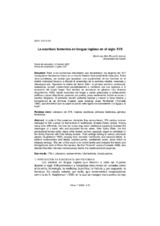La escritura femenina en lengua inglesa en el siglo XVII
Autor
Rivas Carmona, M. del Mar
Editor
UCOPressFecha
2008Materia
Literatura del XVIIMujeres escritoras
Primeras feministas
Géneros femeninos
17th c. Literature
Women writers
First feminists
Female genres
METS:
Mostrar el registro METSPREMIS:
Mostrar el registro PREMISMetadatos
Mostrar el registro completo del ítemResumen
Pese a las numerosas dificultades que encontraron, las mujeres del XVII consiguieron hacerse un hueco en un mundo literario tradicionalmente masculino. Entre otros problemas, las teorías que apoyaban una superioridad de los hombres en el ámbito intelectual llevaron a difundir el estereotipo de la escritora rebelde, insensata y desvergonzada. Siguiendo la estela de Aphra Behn, la primera escritora profesional, numerosas autoras comenzaron paulatinamente a contribuir con sus ingresos a la economía del propio hogar. Sus escritos se enmarcan en géneros muy diversos (Aughterson 1995), desde manuales del hogar y cartas personales a controversias políticas y obras dramáticas, pasando por poesía, prosa sentimental, ficción en prosa o escritos religiosos. El presente estudio pretende repasar y valorar la labor heroica y transgresora de las primeras mujeres, esas primeras voces “feministas” (Richards 1980), que decidieron que su papel no podía estar ligado exclusivamente a la aguja y al fogón. In spite of the numerous obstacles they encountered, 17th century women managed to find a place for themselves in traditionally all-male literary circles. Among many other difficulties, the theories concerning men‟s intellectual superiority fostered the stereotype of a rebel, wild and impudent female writer. After Aphra Behn, the first professional female writer, many other women authors gradually began to contribute to the family finances with their literary income. Their writings belong to various discourse genres (Aughterson 1995), ranging from domestic handbooks and personal letters, to political controversies and drama, besides poetry, sentimental prose, prose fiction or religious writings. The aim of this study is to review briefly and evaluate the heroic and transgressive work of those first women, the first “feminist” voices (Richards 1980), who decided that their role was not exclusively tied to the needle and stew anymore.

